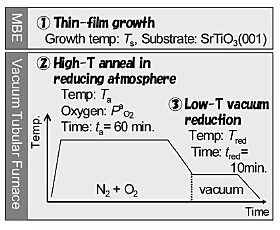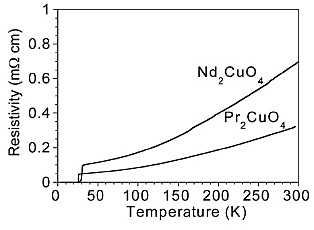Materials Science Laboratory, *Tokyo Univ. of Agricul. & Technol.
It is commonly believed that the parent compounds of high-Tc cupratres are, universally, Mott insulators (charge-transfer insulators).
There has been, however, accumulating evidence that indicates a series
of parent compounds T’-RE2CuO4 [RE stands for rare earth element] are superconductors with Tc even exceeding 30 K when they are optimally synthesized [1]. Most of the recent progress has been achieved by using the metal-organic decomposition (MOD) method [1]. Most likely, this originates from the necessity of removing impurity interstitial oxygen while simultaneously preserving regular oxygen sites occupied, which is a prerequisite for achieving superconductivity in square-coplanar CuO2 plane. It appears that this requirement is easier to be fulfilled in the
MOD films due to rather small grains in them [2], which in turn makes it
difficult to reproduce the results using other synthesis methods. In this
study, we systematically investigated the post-reduction process using
MBE-grown T’-RE2CuO4 (RE=Pr, Nd) films on SrTiO3 (001) substrates for an easier reproduction through a better understanding of the process.
Figure 1 shows several important parameters in the growth and post-reduction
procedures. To make the parent compounds superconducting, a specially-designed
2-step reduction process was necessary, as in the case of MOD films. By
optimizing oxygen partial pressure and annealing temperature with constant
duration, the MBE-grown RE2CuO4 (RE=Pr, Nd) films show superconductivity (Fig. 2) [3].
These findings are useful for synthesizing bulk specimens of the parent
compound superconductors, which makes evaluation of oxygen stoichiometry
feasible. They are also useful for synthesizing the thin-film specimens
through an all-UHV process, with which a direct observation of electronic
structure by photoemission spectroscopy becomes possible. Both will lead
us toward the true electronic phase diagram for high-Tc cuprates.
[1] O. Matsumoto et al., Phys. Rev. B 79 (2009) 100508; Physica C 469 (2009) 924.
[2] O. Matsumoto, A. Tsukada, H. Yamamoto, T. Manabe, and M. Naito, Physica C (in press).
[3] H. Yamamoto, A. Tsukada, O. Matsumoto, and M. Naito, Physica C (in press).
 |
 |
|||||
|
|